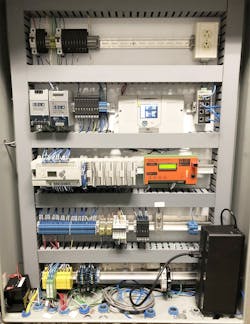Precision Flow Reconciliation
About the author:
Dara Drawdy is technical communications coordinator for Mission Communications. Drawdy can be reached at [email protected].
When the traditional SCADA system at Franklin Sebastian Public Water Authority, which services Lavaca and Charleston, Arkansas, became outdated, the authority needed a new solution.
Dwayne Wallace, water manager, began researching, talking to friends and colleagues, and attending trade shows. Mission Communications was suggested by multiple people, but when one of the utility’s own sitting board members highly recommended the system, Wallace sought out more information.
“Jack Wells of RiverSouth has Mission and is one of our board members at Franklin Sebastian, so whenever we got ready to change, I reached out to Joshua Christiansen,” Wallace said. “I’d seen Mission at the trade show in Hot Springs last year, and I had talked to Joshua about it. And Jack was filling me in on a lot of it because he’s using it. He loves it.”
Wallace contacted Joshua Christiansen, a branch manager at Bertrem Products, to learn more about the Mission system.
“They had previous traditional SCADA,” Christiansen said, “and they weren’t satisfied with the integrator. Now Franklin Sebastian is all Mission.”
Christiansen walked Wallace through the Mission system and the customizable options.
Accurate Flow Measurement
A major factor for their water transmission line, which moves approximately 500,000 gallons per day, was a reconcilable flow count. To ensure precise reporting, Christiansen presented a joint effort with EtherMeter — a product from ScadaMetrics — and Mission Communications. The EtherMeter unit receives information from the meter and transmits that to the Mission RTU.
The orange EtherMeter sends master meter readings to the Mission RTU to be transmitted to the Mission server for data collection and reporting.
Some utilities use pulse signals to report differential flow. Over time, the sum of the individual readings can get out of sync with the meter head and require re-synchronization. While this may not be a concern for flow studies, Franklin Sebastian uses meter readings to determine billing for each of the cities’ customers, which means it needs the flow count to be reconcilable from meter head to customer bill. As such, recording the actual meter reading is critical to conveyance applications like this.
Christiansen explained how the EtherMeter works in conjunction with Mission RTUs to ensure accurate readings.
“What’s cool about the EtherMeter is that it plugs in, instead of doing a pulse output or a 4-20 [mA] signal where we have to calibrate it for Mission or range it on the Mission, it will have an encoder on it, an eight-wheel encoder on it,” Christiansen said. “The EtherMeter reads the register wheels, which sends the reading to Mission. It reads the exact number off the flow meter for better accuracy.”
Solving Industry Problems
The Mission Instrumentation Partner Program (MIPP) allows for remote monitoring of customers’ OEM instrumentation. The program connects Mission RTUs via modbus to collect and compile data that can then be viewed via the 123SCADA web portal or mobile app. MIPP offers customized solutions depending on customer needs. ScadaMetrics is the latest addition to the program, which includes pump controllers from Primex (PC3000), Evoqua (Link2Site) and Flyte (MultiSmart).
Blanton Radford, hardware and firmware team lead at Mission, steered the EtherMeter project. He took time to discuss the endeavor.
“We’re trying to do industry problem solving rather than customer-specific problem solving,” Radford said. “The phrase ‘problem solving’ here is important. We want to avoid asking our customers, ‘What do you want this to do?’ They can’t tell us how our product should work to do something for them. But they know what their problems are.”
End-users increasingly want a simple, managed telemetry solution for their remote assets where actionable information is all in one place, and installers want to minimize installation time while providing all the data points that are useful for remote monitoring and data trending.
“And as the vendor, it’s on us to ask the right questions. We need to ask what problems they’re trying to solve and let them know the solutions we can apply to it, or if we can come up with a new solution that solves the problem,” Radford added. “That’s how the project came together. The problem for the customer was, ‘How can I get my meter reading in my Mission data?’ That’s what we were trying to solve.”
By connecting Mission RTUs to the EtherMeter units, data is sent to the Mission servers and is easily accessible on the web portal or mobile app. This convenience was important to Wallace.
“Being able to work everything from your phone or from any computer to be able log in anywhere. It’s just a big plus,” Wallace said.
Information collected from the EtherMeter and other Mission RTUs is available on a number of reports and charts. Daily, weekly and monthly reports can be setup to automatically email out. This data helps Wallace and his team keep track of the system.
